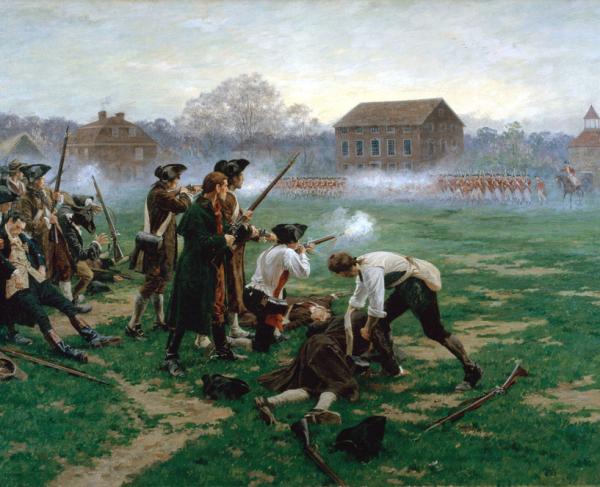
Riding on the Eve of Revolution: 1775 Perspectives Lesson Plan
A lesson plan for use in middle and high school classrooms.
On April 18, 1775, the British planned yet another search and destroy mission, aimed at removing arms and supplies from the countryside. Their target was the village of Concord, a hotbed of anti-British sentiment and a major supply cache. Anti-British intelligence in Boston quickly alerted Patriot leader Dr. Joseph Warren, who gave the fateful order to send the alarm, lighting the fuse that would start the Revolution. Warren sent for Revere and William Dawes in the evening on April 18, once the British intention was clear. Revere would take the short, but more dangerous, water route from Boston across the harbor to Charlestown, while Dawes would ride out across Boston Neck. Warren was concerned that John Hancock and Samuel Adams, both staying in Lexington, were the targets of the British foray. Revere had ridden through Lexington earlier in April, carrying messages to the Provincial Congress meeting in Concord, and knew the route well.
Revere and Dawes departed Boston around 10pm. At the same time, two signal lanterns briefly showed from the Old North Church steeple, a prearranged signal designed by Revere to alert the alarm network across the Harbor. The famous “one if by land, two if by sea” signaled that the British would row across Boston harbor instead of marching out over the neck. Even before Revere landed, the alarm was already spreading across the countryside.
Upon reaching the Charlestown shore, Revere mounted and began his ride to Lexington. Passing through the towns of Somerville, Medford, and Menotomy (Arlington), Revere did not yell “the British are coming!”, instead accounts show that Revere passed the message of “the Regulars are coming out.” The phrase “the British are coming,” would have been confusing to locals, who still considered themselves British. Everyone knew what “the Regulars are coming out” meant, and as Revere passed through, more alarm riders rode out, signal guns fired, church bells rang, all alerting the countryside to the coming threat. As the alarm spread, Minutemen grabbed their weapons and headed for town greens, followed by the rest of the Militia.
This Lesson Plan can be used as a prepared resource by following this curriculum plan which aligns to NCSS and Common Core Standards.
This Lesson Plan's assets can also be used on their own as supplemental resources. The display format is prepared for easy access, exploring, and learning.
1775 Perspectives Module
Upon completion of this lesson, the students will be able to:
- Knowledge
- Briefly explain the events of Paul Revere’s ride to warn the Massachusetts villages on April 18, 1775, that a British expedition was leaving Boston and heading to Concord.
2. Comprehension/Application/Analysis
- Examine multiple primary sources to gain an appreciation for Revere and the other midnight messengers.
3. Evaluation
- Discuss findings from primary sources and consider what was at risk on the eve of the American Revolution.
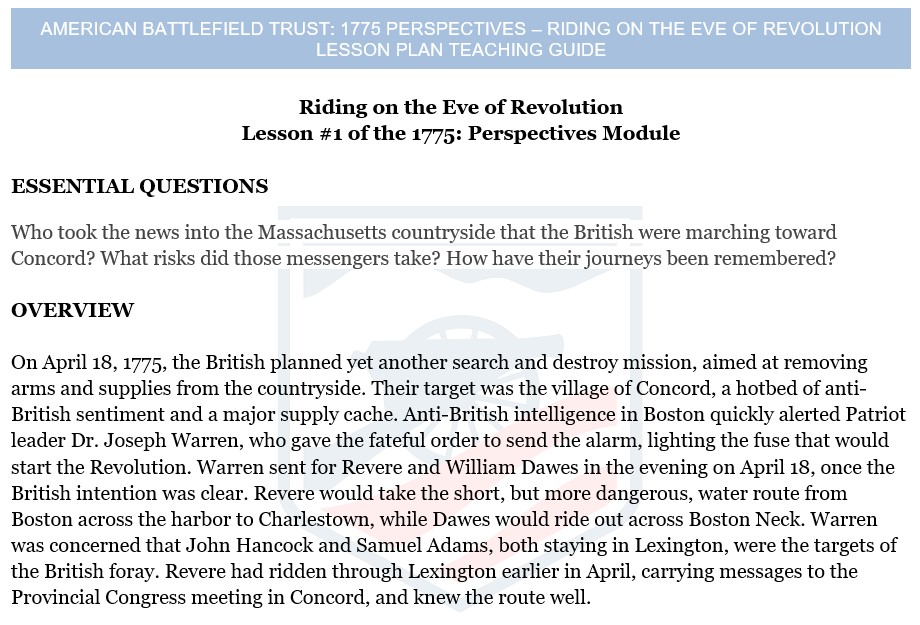
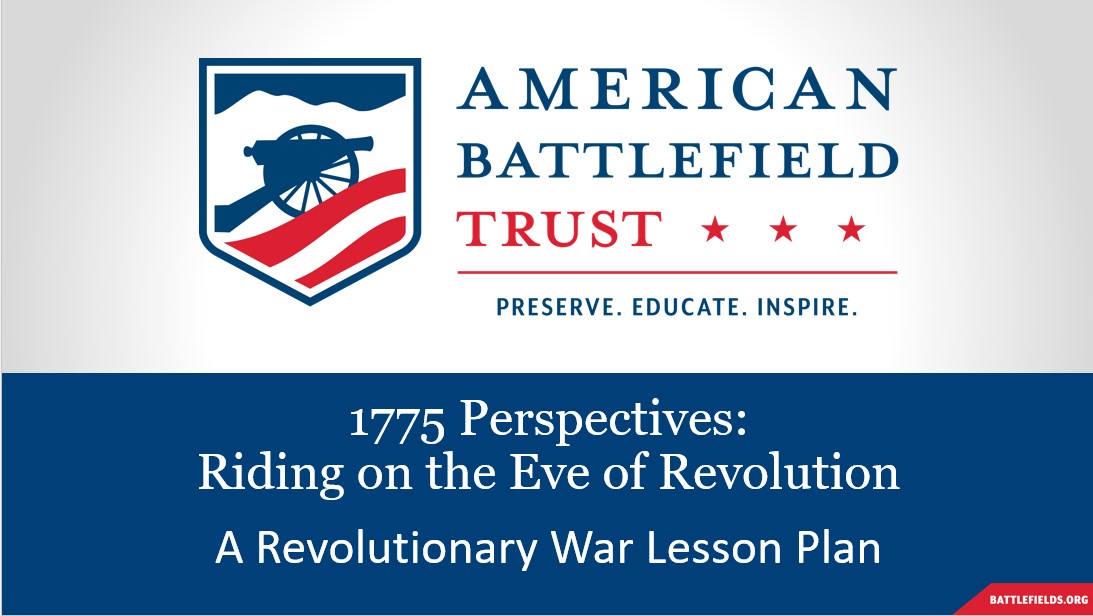
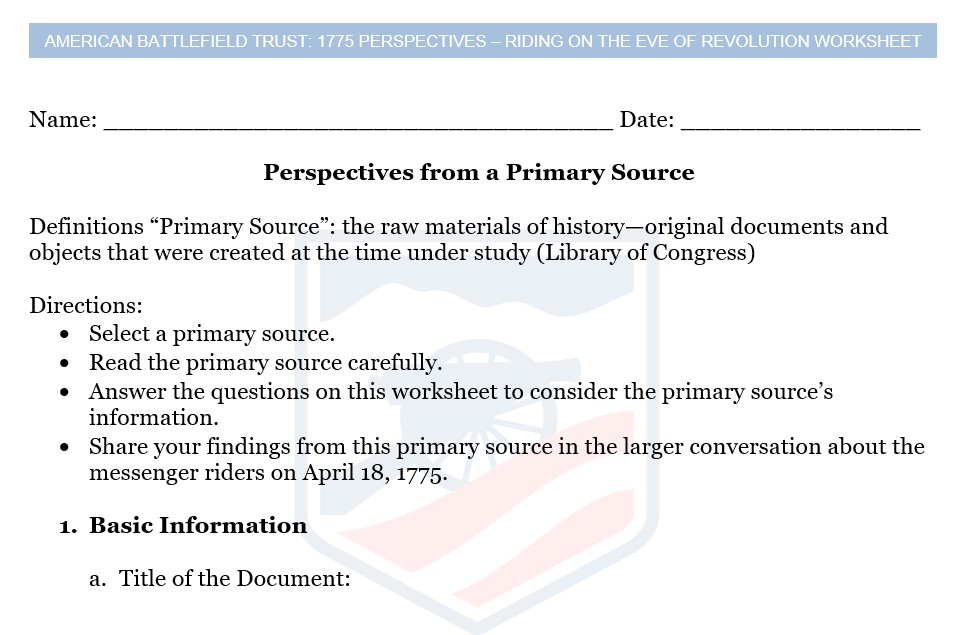
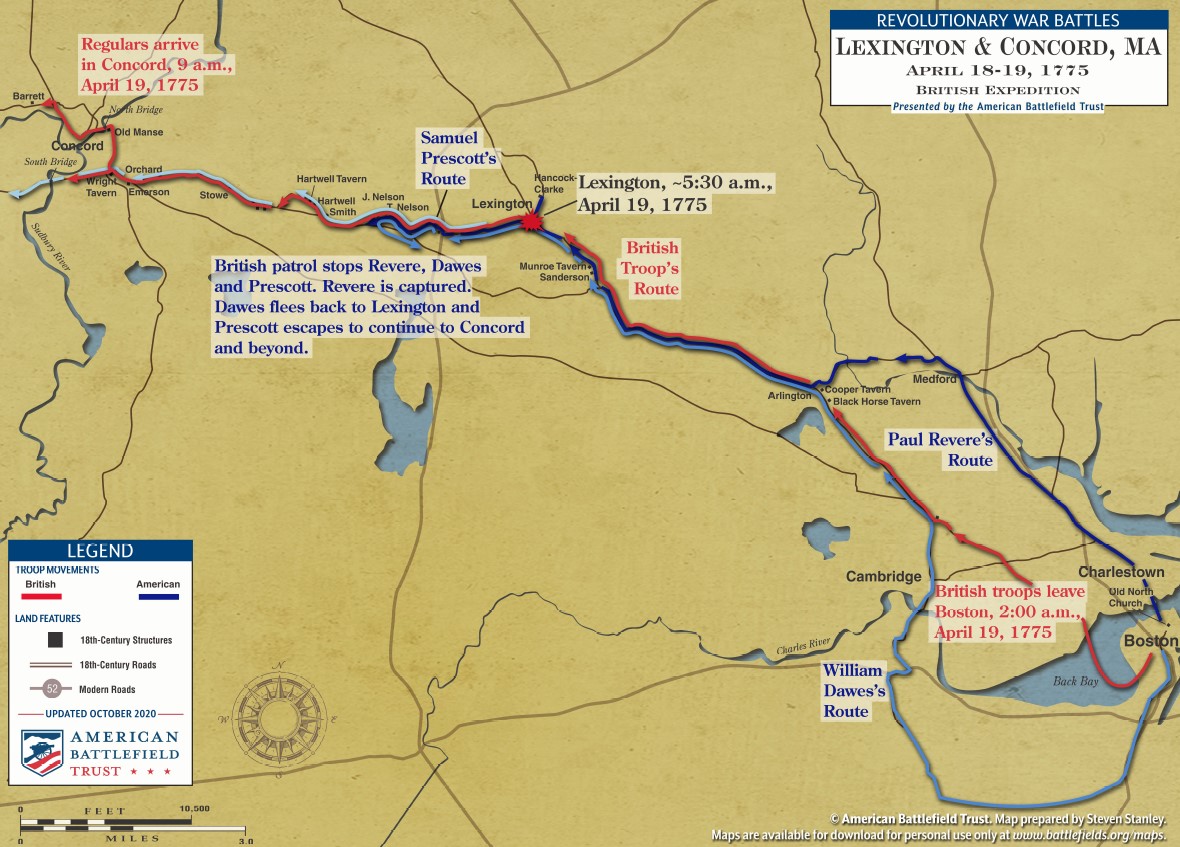
Check out the Lesson Plan Teaching Guide for more instructions on using the prepared Lesson Plan.
Lesson Plan Primary Source Activity:
- Use the Lesson’s PowerPoint to explore the context and history; the PowerPoint introduces context and foundational knowledge for exploring stories and accounts of April 18, 1775.
- Distribute or show in large size the map of the midnight messenger’s route and the route of the British soldiers for students to examine and reference.
- The primary sources for this perspectives lesson plan offer multiple perspectives on different events; students can be divided into groups to read and fill out the worksheet.
| The Ride | Paul Revere’s Deposition, 1775 |
| The Ride | "Describing the Events that Took Place at Lexington and Concord" |
| Revere’s Letters | Rachel Revere’s Captured Letter |
| Revere’s Letters | Paul Revere’s Letters to his wife and son |
| Memory | "Story of the Battle of Concord and Lexington and Revear’s ride Twenty Years Ago" |
- Distribute the lesson’s worksheet.
- Students will read a primary source and fill out the worksheet which will guide them through exploring the document.
- Encourage a class discussion and draw group conclusions, answering the questions:
- What were the goals of the April 18, 1775, for the Americans, the British and the messengers?
- What risks did the midnight messengers take?
- What do you think could have happened if Revere, Dawes and Prescott did not spread the news about the British expedition?
- What makes events “defining” in history?
- How have the messengers been remembered or turned into history myth? How would you suggest the messengers should be remembered?
OPTIONAL HOMEWORK/ASSESSMENT/ADDITIONAL ACTIVITIES:
Option 1: Location Study
Have the students examine the historical map and choose a location along the rider’s route to research. (Some articles and resources are listed on the Lesson Plan Page).
Is this location mentioned in an included primary source? If so, include the quote about the location.
The students can write a paragraph summary about the location, then working together put the locations in sequential and geographical order to describe the messenger’s ride. How far was it between locations? What was the most important location? Why?
Option 2: Boston Virtual Field Trip
Students can watch the Boston Virtual Field Trip, which tours historic Boston, Lexington and Concord. Students can then write a short essay about a place of interest that they saw in the video. For additional resources related to the Boston Virtual Field Trip, including more information about featured sites, please visit this resource hub/landing page.
Common Core State Standards- ELA & History/Social Studies
Grades 6-8
- Key Ideas and Details:
- CCSS.ELA-LITERACY.RH.6-8.1
- Cite specific textual evidence to support analysis of primary and secondary sources.
- CCSS.ELA-LITERACY.RH.6-8.2
- Determine the central ideas or information of a primary or secondary source; provide an accurate summary of the source distinct from prior knowledge or opinions.
- CCSS.ELA-LITERACY.RH.6-8.1
- Craft and Structure:
- CCSS.ELA-LITERACY.RH.6-8.6
- Identify aspects of a text that reveal an author's point of view or purpose (e.g., loaded language, inclusion or avoidance of particular facts).
- CCSS.ELA-LITERACY.RH.6-8.6
- Integration of Knowledge and Ideas:
- CCSS.ELA-LITERACY.RH.6-8.8
- Distinguish among fact, opinion, and reasoned judgment in a text.
- CCSS.ELA-LITERACY.RH.6-8.8
Grades 9-10
- Key Ideas and Details:
- CCSS.ELA-LITERACY.RH.9-10.1
- Cite specific textual evidence to support analysis of primary and secondary sources, attending to such features as the date and origin of the information.
- CCSS.ELA-LITERACY.RH.9-10.2
- Determine the central ideas or information of a primary or secondary source; provide an accurate summary of how key events or ideas develop over the course of the text.
- CCSS.ELA-LITERACY.RH.9-10.3
- Analyze in detail a series of events described in a text; determine whether earlier events caused later ones or simply preceded them.
- CCSS.ELA-LITERACY.RH.9-10.1
- Craft and Structure:
- CCSS.ELA-LITERACY.RH.9-10.5
- Analyze how a text uses structure to emphasize key points or advance an explanation or analysis.
- CCSS.ELA-LITERACY.RH.9-10.6
- Compare the point of view of two or more authors for how they treat the same or similar topics, including which details they include and emphasize in their respective accounts.
- CCSS.ELA-LITERACY.RH.9-10.5
- Integration of Knowledge and Ideas:
- CCSS.ELA-LITERACY.RH.9-10.8
- Assess the extent to which the reasoning and evidence in a text support the author's claims.
- CCSS.ELA-LITERACY.RH.9-10.9
- Compare and contrast treatments of the same topic in several primary and secondary sources.
- CCSS.ELA-LITERACY.RH.9-10.8
Grades 11-12
- Key Ideas and Details:
- CCSS.ELA-LITERACY.RH.11-12.1
- Cite specific textual evidence to support analysis of primary and secondary sources, connecting insights gained from specific details to an understanding of the text as a whole.
- CCSS.ELA-LITERACY.RH.11-12.2
- Determine the central ideas or information of a primary or secondary source; provide an accurate summary that makes clear the relationships among the key details and ideas.
- CCSS.ELA-LITERACY.RH.11-12.3
- Evaluate various explanations for actions or events and determine which explanation best accords with textual evidence, acknowledging where the text leaves matters uncertain.
Craft and Structure:
- Evaluate various explanations for actions or events and determine which explanation best accords with textual evidence, acknowledging where the text leaves matters uncertain.
- CCSS.ELA-LITERACY.RH.11-12.6
- Evaluate authors' differing points of view on the same historical event or issue by assessing the authors' claims, reasoning, and evidence.
- CCSS.ELA-LITERACY.RH.11-12.1
- Integration of Knowledge and Ideas:
- CCSS.ELA-LITERACY.RH.11-12.8
- Evaluate an author's premises, claims, and evidence by corroborating or challenging them with other information.
- CCSS.ELA-LITERACY.RH.11-12.9
- Integrate information from diverse sources, both primary and secondary, into a coherent understanding of an idea or event, noting discrepancies among sources.
- CCSS.ELA-LITERACY.RH.11-12.8
Social Studies - National Council for the Social Studies
- Theme 3: People, Places, and Environments
- Theme 4: Individual Development and Identity
- Theme 5: Individuals, Groups, and Institutions
This Lesson plan
contains the following:
3 Activities | 20 Resources
Audience: Middle school | High school
